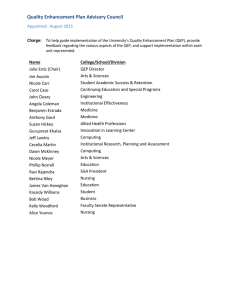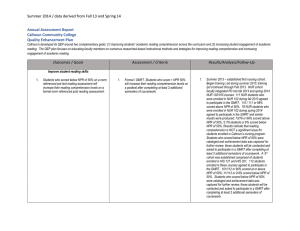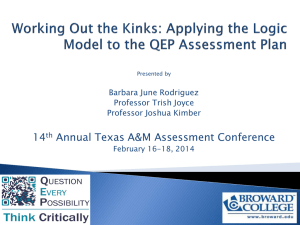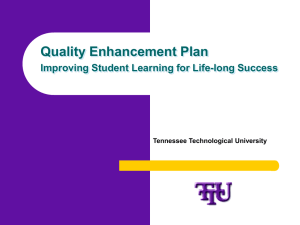Summer 2013 Assessment Report / Data derived from Fall 12... Annual Assessment Report Calhoun Community College
advertisement
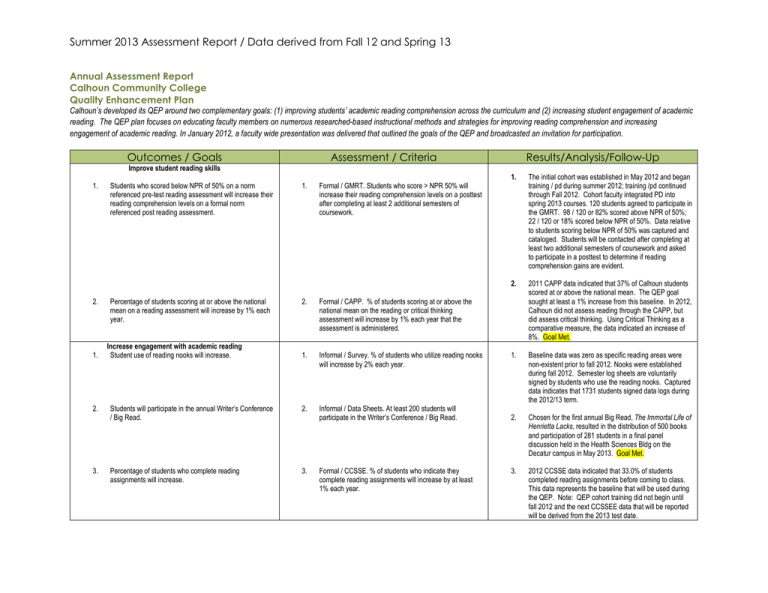
Summer 2013 Assessment Report / Data derived from Fall 12 and Spring 13 Annual Assessment Report Calhoun Community College Quality Enhancement Plan Calhoun’s developed its QEP around two complementary goals: (1) improving students’ academic reading comprehension across the curriculum and (2) increasing student engagement of academic reading. The QEP plan focuses on educating faculty members on numerous researched-based instructional methods and strategies for improving reading comprehension and increasing engagement of academic reading. In January 2012, a faculty wide presentation was delivered that outlined the goals of the QEP and broadcasted an invitation for participation. Outcomes / Goals Assessment / Criteria Results/Analysis/Follow-Up Improve student reading skills 1. 2. 1. 2. 3. Students who scored below NPR of 50% on a norm referenced pre-test reading assessment will increase their reading comprehension levels on a formal norm referenced post reading assessment. Percentage of students scoring at or above the national mean on a reading assessment will increase by 1% each year. 1. Formal / GMRT. Students who score > NPR 50% will increase their reading comprehension levels on a posttest after completing at least 2 additional semesters of coursework. 2. Formal / CAPP. % of students scoring at or above the national mean on the reading or critical thinking assessment will increase by 1% each year that the assessment is administered. 1. Informal / Survey. % of students who utilize reading nooks will increase by 2% each year. Students will participate in the annual Writer’s Conference / Big Read. 2. Informal / Data Sheets. At least 200 students will participate in the Writer’s Conference / Big Read. Percentage of students who complete reading assignments will increase. 3. Increase engagement with academic reading Student use of reading nooks will increase. Formal / CCSSE. % of students who indicate they complete reading assignments will increase by at least 1% each year. 1. The initial cohort was established in May 2012 and began training / pd during summer 2012; training /pd continued through Fall 2012. Cohort faculty integrated PD into spring 2013 courses. 120 students agreed to participate in the GMRT. 98 / 120 or 82% scored above NPR of 50%; 22 / 120 or 18% scored below NPR of 50%. Data relative to students scoring below NPR of 50% was captured and cataloged. Students will be contacted after completing at least two additional semesters of coursework and asked to participate in a posttest to determine if reading comprehension gains are evident. 2. 2011 CAPP data indicated that 37% of Calhoun students scored at or above the national mean. The QEP goal sought at least a 1% increase from this baseline. In 2012, Calhoun did not assess reading through the CAPP, but did assess critical thinking. Using Critical Thinking as a comparative measure, the data indicated an increase of 8%. Goal Met. 1. Baseline data was zero as specific reading areas were non-existent prior to fall 2012. Nooks were established during fall 2012. Semester log sheets are voluntarily signed by students who use the reading nooks. Captured data indicates that 1731 students signed data logs during the 2012/13 term. 2. Chosen for the first annual Big Read, The Immortal Life of Henrietta Lacks, resulted in the distribution of 500 books and participation of 281 students in a final panel discussion held in the Health Sciences Bldg on the Decatur campus in May 2013. Goal Met. 3. 2012 CCSSE data indicated that 33.0% of students completed reading assignments before coming to class. This data represents the baseline that will be used during the QEP. Note: QEP cohort training did not begin until fall 2012 and the next CCSSEE data that will be reported will be derived from the 2013 test date. Summer 2013 Assessment Report / Data derived from Fall 12 and Spring 13 4. 5. Percentage of faculty delivering and assessing instructional information to students through reading assignments will increase. Cohort faculty will continue to integrate specific reading comprehension strategies within their content area after cohort participation. 4. 5. Informal / Survey. % of faculty delivering and assessing instructional information to students through reading assignments will increase by 10% as measured by a post QEP survey among campus wide faculty. Informal / Survey. After QEP training, at least 70% of faculty cohort will continue to integrate specific reading comprehension strategies within their content area. 4. This data will be reported at the conclusion of the QEP. 5. 2012/13 QEP Faculty participated in a survey which indicated 0% relied upon the use of research based reading comprehension strategies in an effort to increase reading comprehension / reading engagement among their students. This goal will be continuously assessed throughout the QEP.

